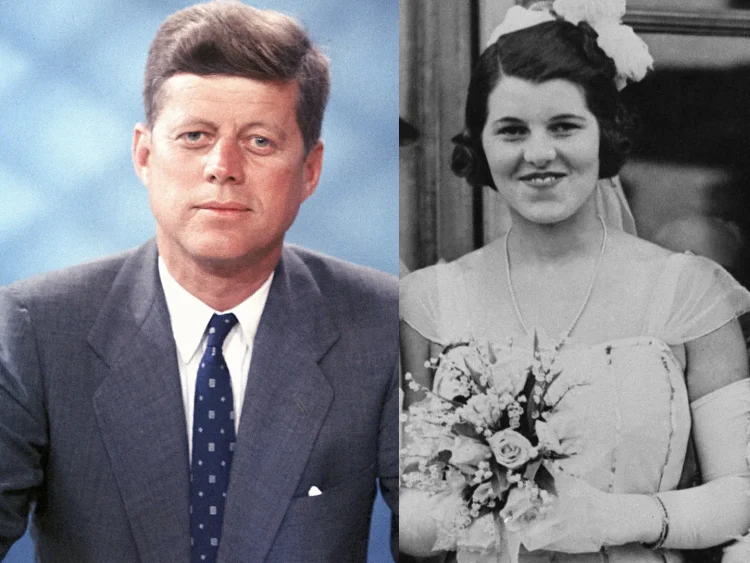: Rosemary Kennedy: A Tragic Tale of Loss and the Impact of Lobotomy

Rosemary Kennedy, the third child of Joseph and Rose Kennedy, was born into one of America’s most influential and politically prominent families in 1918. However, her life took a tragic turn when, at the age of 23, she underwent a lobotomy—a procedure that left her permanently incapacitated. This event not only marked a dark chapter in the Kennedy family history but also raised questions about the ethics and consequences of lobotomy, a once-common but controversial psychiatric treatment.
Early Life and Challenges:
Rosemary’s early life was overshadowed by the pressure of living up to the Kennedy family’s high expectations. With brothers like John F. Kennedy, who would later become the 35th President of the United States, and other siblings excelling in various fields, Rosemary faced the challenge of finding her own identity.
Rosemary’s Developmental Difficulties:
From an early age, it became apparent that Rosemary faced developmental challenges. She struggled with academics, and her behavior was often unpredictable. It was later revealed that Rosemary had intellectual disabilities and mood swings, making it difficult for her to fit into the strict societal norms of the time.
Lobotomy as a Solution:
In the 1940s, when Rosemary was in her early twenties, the Kennedy family sought a solution to her behavioral and emotional challenges. At that time, lobotomy was considered a viable treatment for mental health issues. The procedure involved the surgical severing of connections in the brain’s prefrontal cortex, with the intention of calming disruptive behavior.
The Lobotomy Procedure:
In 1941, without fully understanding the potential consequences, Rosemary’s father, Joseph Kennedy, authorized the lobotomy for his daughter. Dr. Walter Freeman, a prominent neurologist and a strong advocate for lobotomy, performed the procedure. However, the operation did not go as planned, resulting in severe and irreversible damage to Rosemary’s cognitive functions.
The Tragic Outcome:
Following the lobotomy, Rosemary’s condition deteriorated significantly. She lost much of her ability to communicate and function independently. Instead of the intended calming effect, the procedure left her in a more incapacitated state. The Kennedy family, deeply affected by the tragic outcome, sought to keep Rosemary’s condition private, adding a layer of secrecy to the family’s already carefully curated public image.
Impact on the Kennedy Family:
The impact of Rosemary’s lobotomy reverberated through the Kennedy family. Guilt and regret haunted Joseph Kennedy, who had made the decision to proceed with the procedure. The family’s commitment to public service and their advocacy for people with disabilities took on a more personal dimension as they navigated the challenges of caring for Rosemary.
Changing Perspectives on Lobotomy:
As the years passed, the medical community and society as a whole began to reassess the ethics and effectiveness of lobotomy. The procedure fell out of favor due to its unpredictable outcomes and the emergence of alternative treatments for mental health conditions. Rosemary’s case became a poignant example of the unintended consequences of such drastic interventions.
Advancements in Mental Health Treatment:
Rosemary Kennedy’s tragic experience played a role in prompting advancements in mental health treatment. The field gradually shifted toward more humane and evidence-based approaches, emphasizing therapy, medication, and community support. The stigma surrounding mental health issues also began to erode as society gained a better understanding of these conditions.
Legacy and Advocacy:
In the decades following Rosemary’s lobotomy, the Kennedy family became vocal advocates for individuals with intellectual and developmental disabilities. They channeled their personal tragedy into a commitment to raising awareness, supporting research, and promoting policies that aimed to improve the lives of those facing similar challenges.
Conclusion:
Rosemary Kennedy’s life after the lobotomy serves as a poignant reminder of the ethical complexities surrounding mental health treatment, especially in an era where medical interventions were often driven by desperation rather than informed consent. Her story has contributed to a broader societal understanding of the importance of compassionate and evidence-based care for individuals with mental health challenges, leaving a lasting impact on both the Kennedy family and the field of mental health treatment.
- What led to Rosemary Kennedy’s lobotomy? Rosemary Kennedy underwent a lobotomy in 1941 to address behavioral and emotional challenges. The decision was made by her father, Joseph Kennedy, and the procedure was performed by Dr. Walter Freeman.
- How did the lobotomy impact Rosemary’s cognitive functions? The lobotomy had severe and irreversible consequences on Rosemary’s cognitive functions. Instead of the intended calming effect, it left her in a more incapacitated state, significantly impairing her ability to communicate and function independently.
- Who performed Rosemary’s lobotomy? Dr. Walter Freeman, a prominent neurologist and advocate for lobotomy, performed the procedure on Rosemary Kennedy.
- What was the initial intent behind the lobotomy? The lobotomy was intended to calm Rosemary’s disruptive behavior and emotional instability. At the time, lobotomy was considered a viable treatment for various mental health issues.
- How did the Kennedy family react to the outcome of the lobotomy? The Kennedy family was deeply affected by the tragic outcome of Rosemary’s lobotomy. Guilt and regret haunted Joseph Kennedy, who had authorized the procedure. The family kept Rosemary’s condition private, adding a layer of secrecy to their public image.
- How did Rosemary’s condition change after the lobotomy? Following the lobotomy, Rosemary’s condition deteriorated significantly. She lost much of her ability to communicate and function independently, and the procedure did not achieve the intended calming effect.
- Did the Kennedy family acknowledge Rosemary’s condition publicly? No, the Kennedy family kept Rosemary’s condition private, and the details of her lobotomy were not disclosed to the public for many years. The family maintained a carefully curated public image, and Rosemary’s story remained largely unknown to the public.
- How did Rosemary’s lobotomy impact the Kennedy family’s advocacy work? Rosemary’s lobotomy had a profound impact on the Kennedy family’s commitment to advocacy. They became vocal advocates for individuals with intellectual and developmental disabilities, channeling their personal tragedy into raising awareness and supporting research.
- What was the societal perception of lobotomy during that era? During the era in which Rosemary underwent the lobotomy, the procedure was seen as a potential solution to various mental health issues. However, as time passed, societal perspectives on lobotomy evolved, and it fell out of favor due to its unpredictable outcomes and the emergence of alternative treatments.
- How did Rosemary Kennedy’s story contribute to changes in mental health treatment? Rosemary’s tragic experience contributed to a broader reassessment of the ethics and effectiveness of lobotomy. Her story, along with other similar cases, prompted advancements in mental health treatment, leading to a shift towards more humane and evidence-based approaches.






